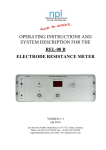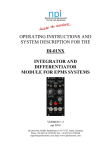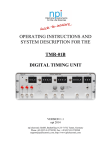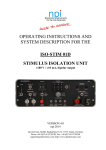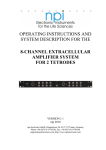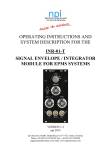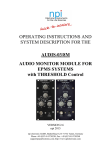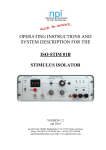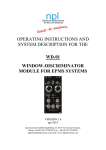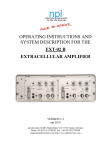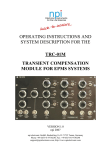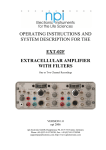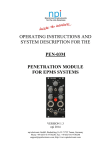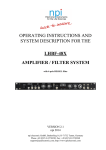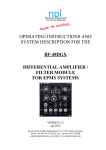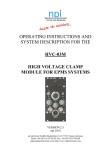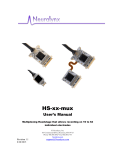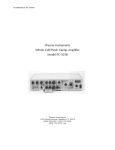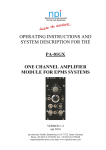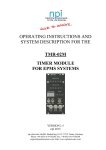Download R/I-1TM Manual - NPI Electronic Instruments
Transcript
OPERATING INSTRUCTIONS AND SYSTEM DESCRIPTION FOR THE R/I-T1M ELECTRODE RESISTANCE TEST CURRENT INJECTION MODULE FOR EPMS SYSTEMS VERSION 1.2 npi 2014 npi electronic GmbH, Bauhofring 16, D-71732 Tamm, Germany Phone +49 (0)7141-9730230; Fax: +49 (0)7141-9730240 [email protected]; http://www.npielectronic.com R/I-T1M User Manual _______________________________________________________________________________________________________________ Table of Contents 1. Safety Regulations .............................................................................................................. 3 2. EPMS-07 Modular Plug-In System .................................................................................... 4 2.1. General System Description / Operation ..................................................................... 4 2.2. EPMS-07 Housing ....................................................................................................... 4 2.3. EPMS-E-07 Housing ................................................................................................... 4 2.4. PWR-03D .................................................................................................................... 4 2.5. System Grounding ....................................................................................................... 5 2.6. Technical Data ............................................................................................................. 5 3. R/I-T1M Resistance Test / Current Injection Module ........................................................ 6 Frequency and Amplitude of Current Injection Pulse ................................................. 8 4. Technical Data .................................................................................................................... 8 ___________________________________________________________________________ version 1.2 page 2 R/I-T1M User Manual _______________________________________________________________________________________________________________ 1. Safety Regulations VERY IMPORTANT: Instruments and components supplied by npi electronic are NOT intended for clinical use or medical purposes (e.g. for diagnosis or treatment of humans), or for any other life-supporting system. npi electronic disclaims any warranties for such purpose. Equipment supplied by npi electronic must be operated only by selected, trained and adequately instructed personnel. For details please consult the GENERAL TERMS OF DELIVERY AND CONDITIONS OF BUSINESS of npi electronic, D-71732 Tamm, Germany. 1) GENERAL: This system is designed for use in scientific laboratories and must be operated by trained staff only. General safety regulations for operating electrical devices should be followed. 2) AC MAINS CONNECTION: While working with the npi systems, always adhere to the appropriate safety measures for handling electronic devices. Before using any device please read manuals and instructions carefully. The device is to be operated only at 115/230 Volt 60/50 Hz AC. Please check for appropriate line voltage before connecting any system to mains. Always use a three-wire line cord and a mains power-plug with a protection contact connected to ground (protective earth). Before opening the cabinet, unplug the instrument. Unplug the instrument when replacing the fuse or changing line voltage. Replace fuse only with an appropriate specified type. 3) STATIC ELECTRICITY: Electronic equipment is sensitive to static discharges. Some devices such as sensor inputs are equipped with very sensitive FET amplifiers, which can be damaged by electrostatic charge and must therefore be handled with care. Electrostatic discharge can be avoided by touching a grounded metal surface when changing or adjusting sensors. Always turn power off when adding or removing modules, connecting or disconnecting sensors, headstages or other components from the instrument or 19” cabinet. 4) TEMPERATURE DRIFT / WARM-UP TIME: All analog electronic systems are sensitive to temperature changes. Therefore, all electronic instruments containing analog circuits should be used only in a warmed-up condition (i.e. after internal temperature has reached steady-state values). In most cases a warm-up period of 20-30 minutes is sufficient. 5) HANDLING: Please protect the device from moisture, heat, radiation and corrosive chemicals. ___________________________________________________________________________ version 1.2 page 3 R/I-T1M User Manual _______________________________________________________________________________________________________________ 2. EPMS-07 Modular Plug-In System 2.1. General System Description / Operation (1) The npi EPMS-07 is a modular system for processing of bioelectrical signals in electrophysiology. The system is housed in a 19” rackmount cabinet (3U) has room for up to 7 plug-in units. The plug-in units are connected to power by a bus at the rear panel. (2) The plug-in units must be kept in position by four screws (M 2,5 x 10). The screws are important not only for mechanical stability but also for proper electrical connection to the system housing. Free area must be protected with covers. 2.2. EPMS-07 Housing The following items are shipped with the EPMS-07 housing: EPMS-07 cabinet with built-in power supply Mains cord Fuse 2 A / 1 A, slow Front covers (3) In order to avoid induction of electromagnetic noise the power supply unit, the power switch and the fuse are located at the rear of the housing. 2.3. EPMS-E-07 Housing The following items are shipped with the EPMS-E-07 housing: EPMS-E-07 cabinet External Power supply PWR-03D Power cord (PWR-03D to EPMS-E-07) Mains chord Fuse 1.6 A / 0.8 A, slow Front covers The EPMS-E-07 housing is designed for low-noise operation, especially for extracellular and multi channel amplifiers with plugged in filters. It operates with an external power supply to minimize distortions of the signals caused by the power supply. 2.4. PWR-03D The external power supply PWR-03D is capable of driving up to 3 EPMS-E housings. Each housing is connected by a 6-pole cable from the one of the three connectors on the front panel of the PWR-03D to the rear panel of the respective EPMS-E housing. (see Figure 1, Figure 3). A POWER LED indicates that the PWR-03D is powered on (see Figure 1). Power switch, voltage selector and fuse are located at the rear panel (see Figure 2). Note: The chassis of the PWR-03D is connected to protective earth, and it provides protective earth to the EPMS-E housing if connected. ___________________________________________________________________________ version 1.2 page 4 R/I-T1M User Manual _______________________________________________________________________________________________________________ Figure 1: PWR-03D front panel view Figure 2: PWR-03D rear panel view Note: This power supply is intended to be used with npi EPMS-E systems only. 2.5. System Grounding EPMS-07 The 19" cabinet is grounded by the power cable through the ground pin of the mains connector (= protective earth). In order to avoid ground loops the internal ground is isolated from the protective earth. The internal ground is used on the BNC connectors or GROUND plugs of the modules that are inserted into the EPMS-07 housing. The internal ground and mains ground (= protective earth) can be connected by a wire using the ground plugs on the rear panel of the instrument. It is not possible to predict whether measurements will be less or more noisy with the internal ground and mains ground connected. We recommend that you try both arrangements to determine the best configuration. EPMS-E-07 The 19" cabinet is connected to the PROTECTIVE EARTH connector at the rear panel. The chassis is linked to protective earth only if the PWR-03D is connected. It can be connected also to the SYSTEM GROUND (SIGNAL GROUND) on the rear panel of the instrument (see Figure 3). Important:: Always adhere to the appropriate safety measures. Figure 3: Rear panel connectors of the EPMS-E-07 2.6. Technical Data 19” rackmount cabinet, for up to 7 plug-in units Dimensions: 3U high (1U=1 3/4” = 44.45 mm), 254 mm deep EPMS-07 Power supply: 115/230 V AC, 60/50 Hz, fuse 2 A / 1 A slow, 45-60 W EPMS-E-07 External power supply (for EPMS-E): Dimensions of External power supply: 115/230 V AC, 60/50 Hz, fuse 1.6/0.8 A, slow (W x D x H) 225 mm x 210 mm x 85 mm ___________________________________________________________________________ version 1.2 page 5 R/I-T1M User Manual _______________________________________________________________________________________________________________ 3. R/I-T1M Resistance Test / Current Injection Module The R/I-T1M module allows measurement of the resistance of an electrode connected to an extracellular amplifier in the same EPMS housing. The module can function also for injection of current (up to ±280 nA) through a single electrode or through all electrodes simultaneously. The function is selected by a switch and indicated by LEDs. It can be operated manually or remotely using a TTL signal. The two functions can be applied to up to six electrodes. The resistance is determined by application of a fixed pulse of approx. ±10 nA with 200 Hz. The current injection pulses are variable in both frequency and amplitude and symmetric around the baseline. Test and current injection pulses are a triangle-shaped signal fed into the headstage of the EXT amplifier. With the capacitor in the headstage the triangle is differentiated resulting in a rectangular current signal at the electrode. For electrode resistance test the voltage drop at the electrode caused by the current signal is measured and the electrode resistance is calculated due to Ohm’s law: I = R*C. Frequency and amplitude of current injection are dependent on each other according to Ic = C * dU/dt where Ic is the capacitive current, C is the capacitor in the amplifier headstage, dU/dt is the change of the voltage amplitude of the triangle over time. Figure 4: R/I-T1M front panel view ___________________________________________________________________________ version 1.2 page 6 R/I-T1M User Manual _______________________________________________________________________________________________________________ In the following description of the front panel elements each element has a number that is related to that in Figure 4. The number is followed by the name (in uppercase letters) written on the front panel and the type of the element (in lowercase letters). Then, a short description of the element is given. (1) RESISTANCE / CURRENT switch Switch for selecting electrode RESISTANCE test or CURRENT injection. The selected function is indicated by #11 or #2, respectively. (2) CURRENT nA LED LED showing that CURRENT injection is selected. The amplitude of the injected CURRENT is shown in display #3 in nA. (3) RESISTANCE / CURRENT display Digital display showing the tetrode unit resistance (XX.XX M, range: 0.01 M…10 M) or the amplitude of the injected current (XXX nA, range: 0…±280 nA). (4) CHANNEL SELECT indicator LED (XX) indicating the selected CHANNEL for current injection or to be tested for resistance. The indicator starts at 01, e.g. 02 indicates function at CHANNEL 2 (see also #10). (5) AMPLITUDE potentiometer 10-turn Potentiometer for setting the current amplitude (range: 0…±280 nA) (6) OUT connector BNC connector monitoring the amplitude of the injected current (1 V / 100 nA) or the resistance (1 V / 1 M). (7) TTL IN connector BNC connector for remote control of operation with a TTL signal. As long as the signal is HI (> +2.5V) operation takes place. (8) ON push button Push button for activating current injection or resistance test. (9) FREQUENCY potentiometer 10-turn Potentiometer for setting frequency of the current injection pulses (range: 200 Hz…2 kHz) Important: Changing the frequency will also change the amplitude of the current pulse ! (10) CHANNEL SELECT switch Switch for selecting the electrode for current injection to be tested for resistance. Starting at electrode 1 (CHANNEL 01 indicated by #4) turning clockwise increases the electrode number until electrode 6. Turning clockwise further selects all electrodes simultaneously for current injection. This function is indicated by #4 showing CHANNEL 7 (Note that only one digit is shown). ___________________________________________________________________________ version 1.2 page 7 R/I-T1M User Manual _______________________________________________________________________________________________________________ Important: In position CHANNEL 7 the electrode resistance test is disabled. Only current injection will function!! (11) RESISTANCE M LED LED showing that electrode RESISTANCE test is selected. The measured electrode RESISTANCE is shown in display #3 in M. With electrodes >2 M the resistance is shown accurately only if the capacity has been compensated correctly (with EXT-10C). Frequency and Amplitude of Current Injection Pulse Frequency and amplitude of current injection are dependent on each other according to dU IC C dt where Ic is the capacitive current, C is the capacitor in the amplifier headstage (3.3 pF) , dU/dt is the change of the voltage amplitude of the triangle over time. Example for frequency with fixed amplitude of the triangle (±10 V i.e. 20 V amplitude) dU IC C dt or C dU dt IC 3.3 10 12 F 20 V dt 100 nA 660 s because of having a biphasic pulses this has to be multiplied by 2 to get the frequency 660 µs *2 = 1.32 ms 758 Hz 4. Technical Data R/I-T1M Resistance measurement: 0.01…10 M, display: XX.XX M Current injection: 0…±280 nA, symmetrical around baseline; display: XXX nA Output scaling: 1 V / M or 1 V / 100 nA Output: resistance: 50 , range ±10 V ___________________________________________________________________________ version 1.2 page 8








